Central Valley Hydrologic Model Version 2 (CVHM2): Decision Support Tool for Groundwater and Land Subsidence Management
Abstract
1. Introduction
2. Background
3. Methods
- In this application, the CVHM2 is capable of realistically simulating various surface and groundwater management strategies such as a reduced agricultural surface water demand, managed aquifer recharge interventions (MAR), and the potential impacts of climate change.
- The updated CVHM2 provides realistic simulations of aquifer subsidence along the DMC—the primary surface water delivery conveyance for the Delta–Mendota subregion.
- The extended CVHM2 provides appropriate results and analyses, and visualizations of these results can be used to guide water managers (including GSAs and local water districts) and landowners in their potential modification of current water-use management practices and in taking actions to mitigate the effects of potential climate-change/variability impacts and achieve groundwater sustainability.
- Future critical years used WY2008;
- Future below-normal years used WY2009;
- Future dry years used WY2012;
- Future above-normal years used WY2010;
- Future wet years used WY2011.
4. Results
4.1. Sensitivity Analysis
4.2. Future Subsidence as a Function of Groundwater Extraction
| P/MA Zone | GSP Pumping Reduction from Upper Aquifer [AFY] | GSP Pumping Reduction from Lower Aquifer [AFY] | GSP Pumping Reduction Lower + Upper [AFY] |
| 1 | 2798 | 2886 | 5683 |
| 2 | 4619 | 3139 | 7758 |
| 3 | 803 | 9023 | 9826 |
| 4 | 1303 | 17,440 | 18,743 |
| Total Basin | 9523 | 32,488 | 42,010 |
| P/MA Zone | CVHM2 Pumping Reduction from Upper Aquifer [AFY] | CVHM2 Pumping Reduction from Lower Aquifer [AFY] | CVHM2 Pumping Reduction Lower + Upper [AFY] |
| 1 | 12,247 | 3585 | 15,833 |
| 2 | 4505 | 3716 | 8221 |
| 3 | 2044 | 11,080 | 13,124 |
| 4 | 1017 | 19,637 | 20,654 |
| Total Basin | 19,813 | 38,018 | 57,832 |

4.3. The Potential of MAR to Mitigate Subsidence
4.4. Comparison with Recent Subsidence Measurements
4.5. Uncertainty
5. Discussion
- The USGS CVHM2 regional model utilized an updated version of the farm process and incorporated the MODFLOW One Water Hydrologic Flow Model MF-OWHM [14], which provided additional features for the simulation of agricultural irrigation hydrology. This has made the underlying hydrology more transparent (although at the expense of model complexity), with the aim of being aligned with datasets more familiar to agricultural stakeholders.
- The USGS worked for more than 6 years after the release of a prior version of the model (CVHM), allowing time for stakeholder data to be assimilated and utilized directly in the version 2 model. An important refinement has been the disaggregation of water balance subregions into “farms” or subareas which are delineated to closely match (to the extent possible with a 1-mile model grid mesh) political water district boundaries. This was critical in the Delta–Mendota subbasin, where surface drainage is prohibited and where reuse is managed at the water district level.
- Surface and subsurface drainage reuse is widespread within the Delta–Mendota subbasin—some formal and practiced on-farm in the southern part of the subarea and others more informal and regional, where irrigation return flows into surface drains and can be reused. The Grassland water district—a 50,000-acre tract of managed seasonal wetlands—relies heavily on water reuse to flood these wetlands in winter months. Properly accounting for reuse in the Delta–Mendota subregion was critical for successful model calibration [17] and the model’s potential utility as a decision support tool.
- Proper accounting of irrigation water supply, crop evapotranspiration, water reuse, and runoff can help to accurately track groundwater extraction. Subsidence modeling is only credible if groundwater pumping rates and the groundwater pumping response to drought and other climate change-induced perturbations to regional hydrology can be properly accounted for.
- Enhancement of the algorithms encoded in the CVHM2 and used to simulate land subsidence, including the partition of elastic and inelastic compaction and the model’s ability to simulate aquifer interbed drainage, has greatly improved the capabilities of the model. In particular, results from simulations [15] and extensometer measurements [3] in the Delta–Mendota subbasin have demonstrated these enhanced capabilities.
6. Conclusions
Author Contributions
Funding
Data Availability Statement
Acknowledgments
Conflicts of Interest
Abbreviations
| AFY | Acre-ft per year |
| CVHM | Central Valley Hydrologic Model |
| CVHM2 | Central Valley Hydrologic Model v2 |
| CVP | Central Valley Project |
| DMC | Delta–Mendota Canal |
| GSA | Groundwater Sustainability Agency |
| GSP | Groundwater Sustainability Plan |
| HGSSJVM | HydroGeoSphere San Joaquin Valley Model |
| MF-OWHM | MODFLOW-One Water Hydrologic Model |
| MODFLOW | U.S. Geological Survey modular finite-difference flow model |
| MAR | Managed aquifer recharge |
| SGMA | Sustainable Groundwater Management Act |
| SJV | San Joaquin Valley |
| SLDMWA | San Luis Delta–Mendota Water Authority |
| USGS | United States Geological Survey |
Appendix A



References
- Ireland, R.L.; Poland, J.F.; Riley, F.S. Land Subsidence in the San Joaquin Valley, California, as of 1980; US Geological Survey Professional Paper 437-I; USGS Publications Warehouse: Reston, VA, USA, 1984; 93p.
- Lees, M.; Knight, R. Quantification of record-breaking subsidence in California’s San Joaquin Valley. Commun. Earth Environ. 2024, 5, 677. [Google Scholar] [CrossRef]
- Sneed, M.; Brandt, J.; Solt, M. Land Subsidence Along the Delta-Mendota Canal in the Northern Part of the San Joaquin Valley, California, 2003–2010; US Geological Survey Scientific Investigations Report 2013-5142; USGS Publications Warehouse: Reston, VA, USA, 2013; 87p.
- Faunt, C.C.; Sneed, M.; Traum, J.; Brandt, J.T. Water Availability and Land Subsidence in the Central Valley, California, USA. Hydrogeol. J. 2016, 24, 675–684. [Google Scholar] [CrossRef]
- California Department of Water Resources. Sustainable Groundwater Management Act (SGMA). Available online: https://water.ca.gov/Programs/Groundwater-Management/SGMA-Groundwater-Management (accessed on 25 June 2024).
- California Department of Water Resources. California’s Groundwater Update 2020 (Bulletin 118); California Department of Water Resources: Sacramento, CA, USA, 2020.
- Poland, J.F.; Lofgren, B.E.; Ireland, R.L.; Pugh, R.G. Land Subsidence in the San Joaquin Valley, California, as of 1972; US Geological Survey Professional Paper 437-H; USGS Publications Warehouse: Reston, VA, USA, 1975; 78p.
- Belitz, K.; Phillips, S.P.; Gronber, J.M. Numerical Simulation of Ground-Water Flow in the Central Part of the Western San Joaquin Valley, California; Water Supply Paper 2396; USGS Publications Warehouse: Reston, VA, USA, 1993.
- Larson, K.J.; Basagaoglu, H.; Mariño, M.A. Prediction of optimal safe ground water yield and land subsidence in the Los Banos-Kettleman City area, California, using a calibrated numerical simulation model. J. Hydrol. 2001, 242, 79–102. [Google Scholar] [CrossRef]
- Leake, S.A.; Prudic, D.E. Documentation of a computer program to simulate aquifer-system compaction using the modular finite-difference ground water flow model. In US Geological Survey Techniques of Water Resources Investigation, Book 6, Chap. A2; USGS Publications Warehouse: Reston, VA, USA, 1991; 68p. [Google Scholar]
- McDonald, M.G.; Harbaugh, A.W. A modular three-dimensional finite-difference ground-water flow model. In US Geological Survey Techniques of Water Resources Investigations, Book 6, Chap. A1; USGS Publications Warehouse: Reston, VA, USA, 1988; 586p. [Google Scholar]
- Faunt, C.C. (Ed.) Groundwater Availability of the Central Valley Aquifer, California; U.S. Geological Survey Professional Paper 1766; U.S. Geological Survey: Reston, VA, USA, 2009; ISBN 978-1-4113-2515-9.
- Harbaugh, A.W.; Banta, E.R.; Hill, M.C.; McDonald, M.G. MODFLOW-2000: U.S. Geological Survey Modular Ground-Water Model—User Guide to Modularization Concepts and the Ground-Water Flow Process: U.S. Geological Survey Open-File Report 00–92; USGS Publications Warehouse: Reston, VA, USA, 2000; 121p.
- Hoffman, J.; Leake, S.A.; Galloway, D.L.; Wilson, A.M. MODFLOW–2000 Ground-Water Model—User Guide to the Subsidence and Aquifer-System Compaction (SUB) Package: U.S. Geological Survey Open-File Report 03–233; USGS Publications Warehouse: Reston, VA, USA, 2003; 46p.
- Schmid, W.; Hanson, R.T.; Thomas, M., III; Leake, S.A. User Guide for the Farm Process (FMP1) for the U.S. Geological Survey’s Modular Three-Dimensional Finite-Difference Ground-Water Flow Model, MODFLOW-2000: U.S. Geological Survey Techniques and Methods 6-A17; USGS Publications Warehouse: Reston, VA, USA, 2006; 127p.
- Hanson, R.T.; Boyce, S.E.; Schmid, W.; Hughes, J.D.; Mehl, S.M.; Leake, S.A.; Maddock, T.; Niswonger, R.G. One-Water Hydrologic Flow Model (MODFLOW-OWHM) U.S. Geological Survey Techniques and Methods 6–A51; USGS Publications Warehouse: Reston, VA, USA, 2014; 120p. [CrossRef]
- Faunt, C.C.; Traum, J.A.; Boyce, S.E.; Seymour, W.A.; Jachens, E.R.; Brandt, J.T.; Sneed, M.; Bond, S.; Marcelli, M.F. Groundwater Sustainability and Land Subsidence in California’s Central Valley. Water 2024, 16, 1189. [Google Scholar] [CrossRef]
- Brush, C.F.; Dogrul, E.C.; Kadir, T.N. Development and Calibration of the California Central Valley Groundwater-Surface Water Simulation Model (C2VSim), Version 3.02-CG; Technical Memorandum; California Department of Water Resources: Sacramento, CA, USA, 2013.
- Bond, S.; Jachens, E.R.; Faunt, C.C. Central Valley Hydrologic Model Version 2 (CVHM2): Water Banking for Water Years 1961–2019 (Ver. 2.0, Aug 2023); U.S. Geological Survey Data Release; U.S. Geological Survey: Reston, VA, USA, 2022.
- Earll, M.M. Central Valley Hydrologic Model Version 2 (CVHM2): Surface Water Network for Water Years 1922–2019; U.S. Geological Survey Data Release; U.S. Geological Survey: Reston, VA, USA, 2022.
- Faunt, C.C. Central Valley Hydrologic Model Version 2 (CVHM2): Model Setup Files; U.S. Geological Survey Data Release; U.S. Geological Survey: Reston, VA, USA, 2022.
- Faunt, C.C.; Stamos-Pfeiffer, C.L.; Brandt, J.; Sneed, M.; Boyce, S.E. Central Valley Hydrologic Model Version 2 (CVHM2): Observation Data (Groundwater Level, Streamflow, Subsidence) from 1916 to 2018 (Ver. 2.0, June 2023); U.S. Geological Survey Data Release; U.S. Geological Survey: Reston, VA, USA, 2022.
- Marcelli, M.F.; Shepherd, M.M.; Faunt, C.C. Central Valley Hydrologic Model Version 2 (CVHM2): Well Log Lithology Database and Texture Model; U.S. Geological Survey Data Release; U.S. Geological Survey: Reston, VA, USA, 2022.
- Seymour, W.A.; Martin, D. Central Valley Hydrologic Model Version 2 (CVHM2): Climate Data (Precipitation, Evapotranspiration, Recharge, Runoff) from the Basin Characterization Model for Water Years 1922–2019 (Ver. 2.0, June 2023); U.S. Geological Survey Data Release; U.S. Geological Survey: Reston, VA, USA, 2022.
- Seymour, W.A.; Faunt, C.C. Central Valley Hydrologic Model Version 2 (CVHM2): Land Use Properties (Ver. 3.0, October 2023); U.S. Geological Survey Data Release; U.S. Geological Survey: Reston, VA, USA, 2022.
- Traum, J.A. Central Valley Hydrologic Model Version 2 (CVHM2): Subsidence Package; U.S. Geological Survey Data Release; U.S. Geological Survey: Reston, VA, USA, 2022.
- Traum, J.A.; Faunt, C.C. Central Valley Hydrologic Model Version 2 (CVHM2): Groundwater Pumping; U.S. Geological Survey Data Release; U.S. Geological Survey: Reston, VA, USA, 2022.
- Boyce, S.E.; Hanson, R.T.; Ferguson, I.; Schmid, W.; Henson, W.R.; Reimann, T.; Mehl, S.W.; Earll, M.M. One-Water Hydrologic Flow Model: A MODFLOW Based Conjunctive-Use Simulation Software; Techniques and Methods 6-A60; U.S. Geological Survey: Reston, VA, USA, 2020; 435p. [CrossRef]
- Boyce, S.E. MODFLOW One-Water Hydrologic Flow Model (MF-OWHM) Conjunctive Use and Integrated Hydrologic Flow Modeling Software, Version 2.3.0; U.S. Geological Survey Software Release; U.S. Geological Survey: Reston, VA, USA, 2024. [CrossRef]
- Nelson, K.E. Technical Memorandum—“Estimated Subsidence Projections Along the Delta-Mendota-Canal (DMC)”; US Bureau of Reclamation: Washington, DC, USA, 2019.
- Nelson, K.E. Science & Technology Program Final Report ST-2017-3117-01—“Evaluation of Land Subsidence Impacts Due to Groundwater Pumping Near the Delta-Mendota-Canal (DMC)”; Science & Technology Program Final Report ST-2017-3117-01; US Bureau of Reclamation: Washington, DC, USA, 2017.
- Galloway, D.; Jone, D.R.; Ingebritsen, S.E. Mining ground water. Land subsidence in the United States; U.S. Geological Survey; U.S. Geological Survey: Reston, VA, USA, 1999; Volume 1182, pp. 7–34.
- Delta-Mendota SGMA (Delta-Mendota SGMA—Delta-Mendota SGMA) and Eki Environment& Water. Groundwater Sustainability Plan for the Delta-Mendota Subbasin—June 2024 Public Review Draft; Delta-Mendota SGMA (Delta-Mendota SGMA—Delta-Mendota SGMA) and Eki Environment & Water: Daly City, CA, USA, 2024. [Google Scholar]
- Nelson, K. Draft Technical Memorandum—Review of Delta-Mendota Groundwater Sustainability Plan (GSP); US Bureau of Reclamation: Washington, DC, USA, 2024.
- Turner, S.W.D.; Hejazi, M.; Calvin, K.; Kyle, P.; Kim, S. A Pathway of Global Food Supply Adaptation in a World with Increasingly Constrained Groundwater. Sci. Total Environ. 2019, 673, 165–176. [Google Scholar] [CrossRef]
- Bierkens, M.F.P.; Wada, Y. Non-Renewable Groundwater Use and Groundwater Depletion: A Review. Environ. Res. Lett. 2019, 14, 063002. [Google Scholar] [CrossRef]
- Pierre, J.; Farr, T.G.; Rutqvist, J.; Vasco, D.W. Role of agricultural activity on land subsidence in the San Joaquin Valley, California. J. Hydrol. 2019, 569, 462–469. [Google Scholar]
- Corbett, F.; Schetrit, T.; Harter, T. Crop Water Use, Groundwater Flow, and Subsidence at Naval Air Station Lemoore, Fresno and Kings County, California, Final Report; California Cooperative Ecosystem Studies Unit, Department of Defense, The Regents of the University of California: Davis, CA, USA, 2011.
- Dillon, P.; Stuyfzand, P.; Grischek, T.; Lluria, M.; Pyne, R.D.G.; Jain, R.C.; Bear, J.; Schwarz, J.; Wang, W.; Fernandez, E.; et al. Sixty Years of Global Progress in Managed Aquifer Recharge. Hydrogeol. J. 2019, 27, 1–30. [Google Scholar] [CrossRef]
- California Department of Water Resources. Flood-MAR: Using Flood Water for Managed Aquifer Recharge to Support Sustainable Water Resources; California Department of Water Resources: Sacramento, CA, USA, 2018.
- Prokopovich, N.P.; Hebert, D.J. Land Subsidence Along the Delta-Mendota Canal, California. JAWRA J. Am. Water Resour. Assoc. 1968, 60, 915–920. [Google Scholar] [CrossRef]
- Sneed, M.; Brandt, J. Land subsidence in the San Joaquin Valley, California, USA, 2007–2014. Proc. Int. Assoc. Hydrol. Sci. 2015, 372, 23–27. [Google Scholar] [CrossRef]
- Vasco, D.W.; Farr, T.G.; Pierre, J.; Doughty, C.; Nico, P. Satellite-based monitoring of groundwater depletion in California’s Central Valley. Sci. Rep. 2019, 9, 16053. [Google Scholar] [CrossRef] [PubMed]
- Jones, J.; Jones, C.E.; Bekaert, D.P.S. Value of InSAR for Monitoring Land Subsidence to Support Water Management in the San Joaquin Valley, California. JAWRA J. Am. Water Resour. Assoc. 2022, 58, 995–1001. [Google Scholar] [CrossRef]
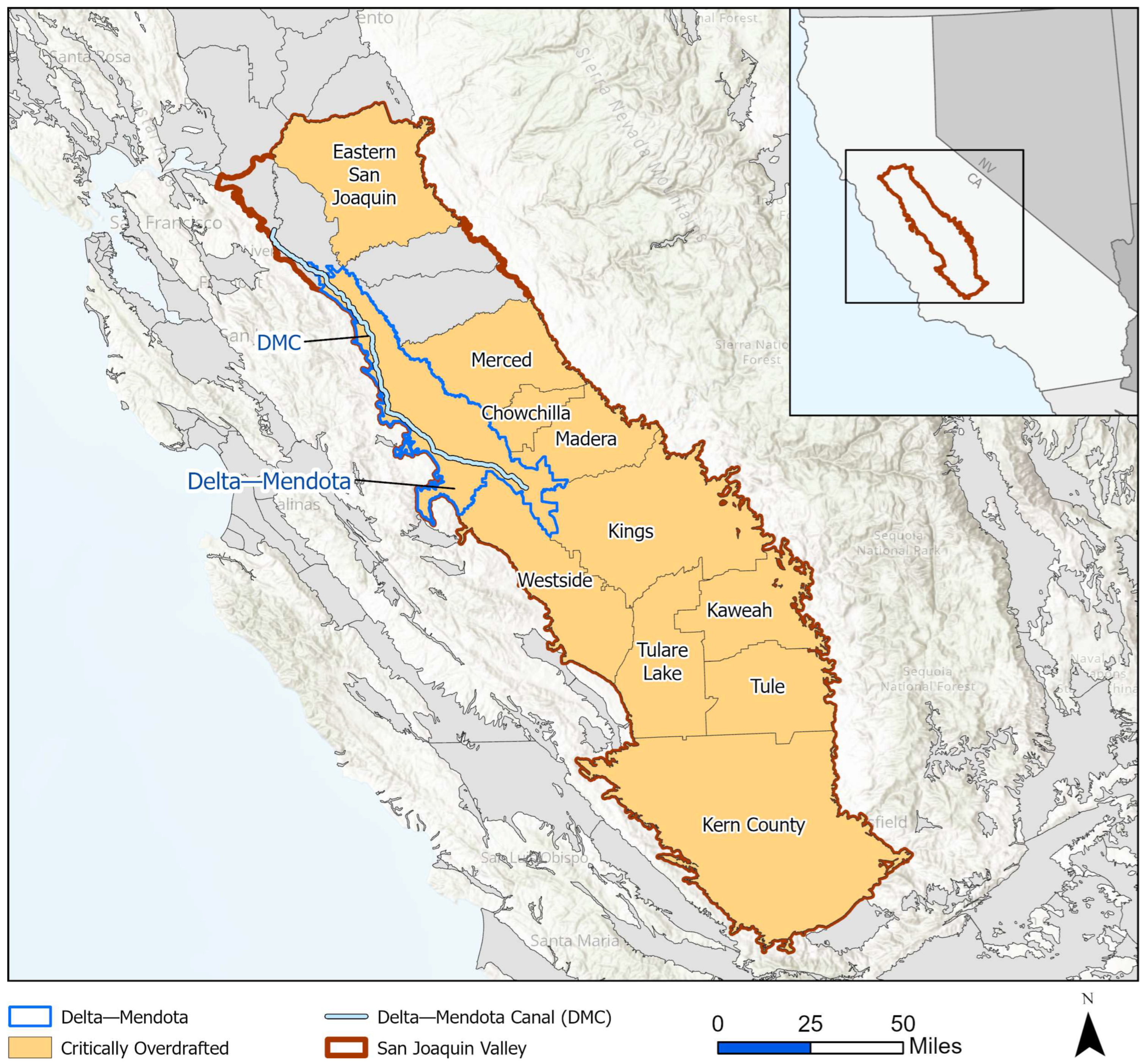
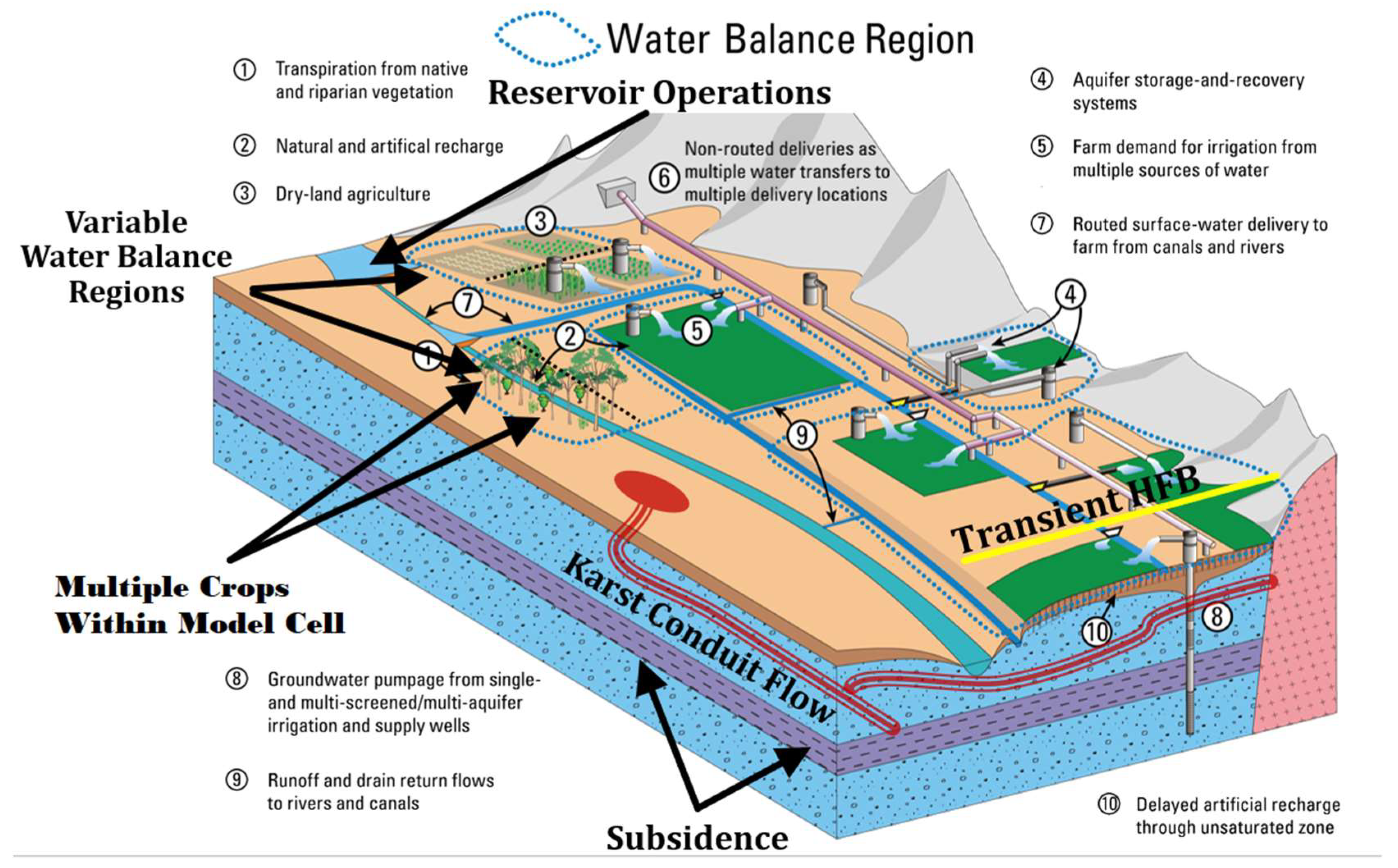
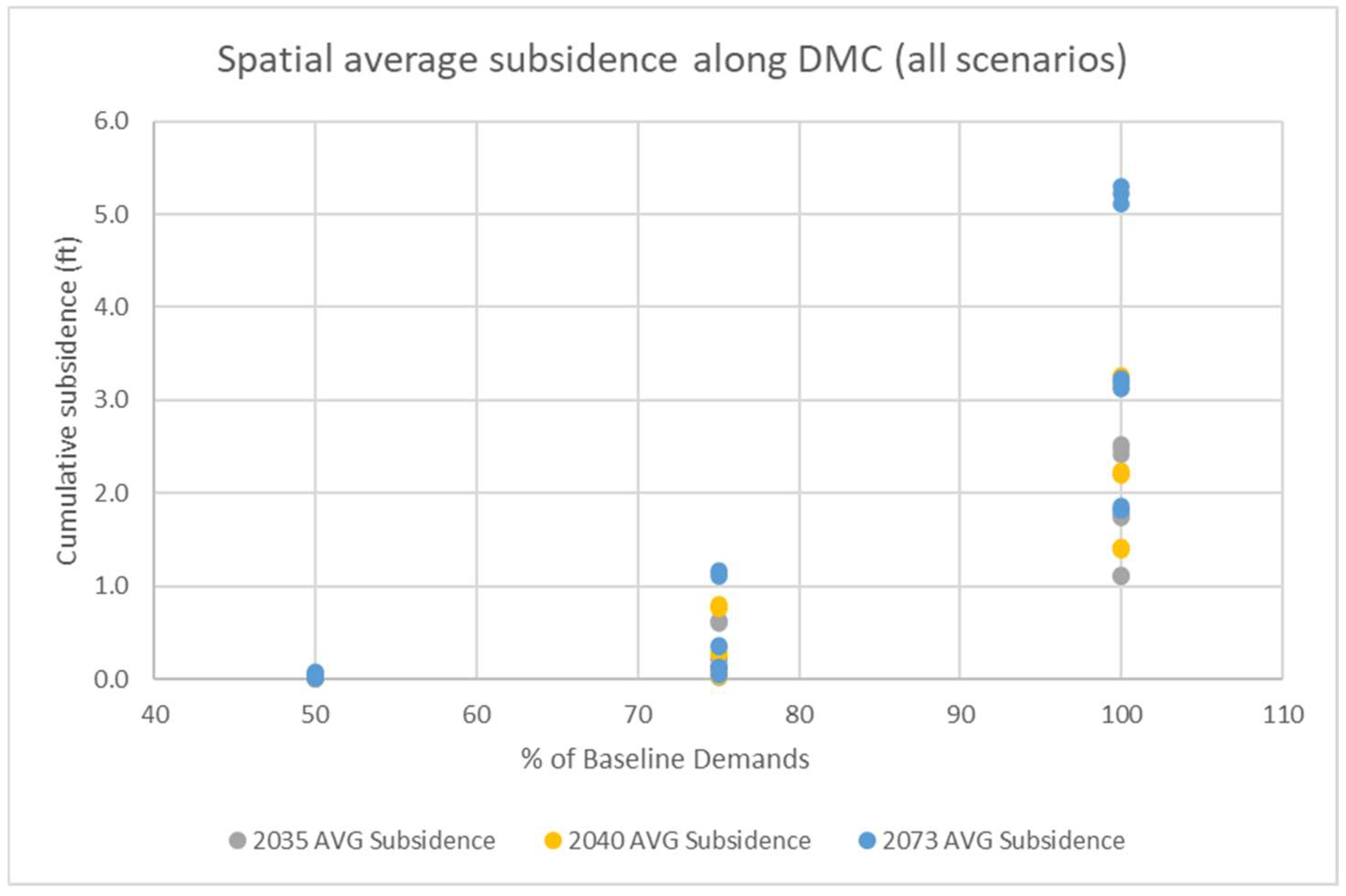
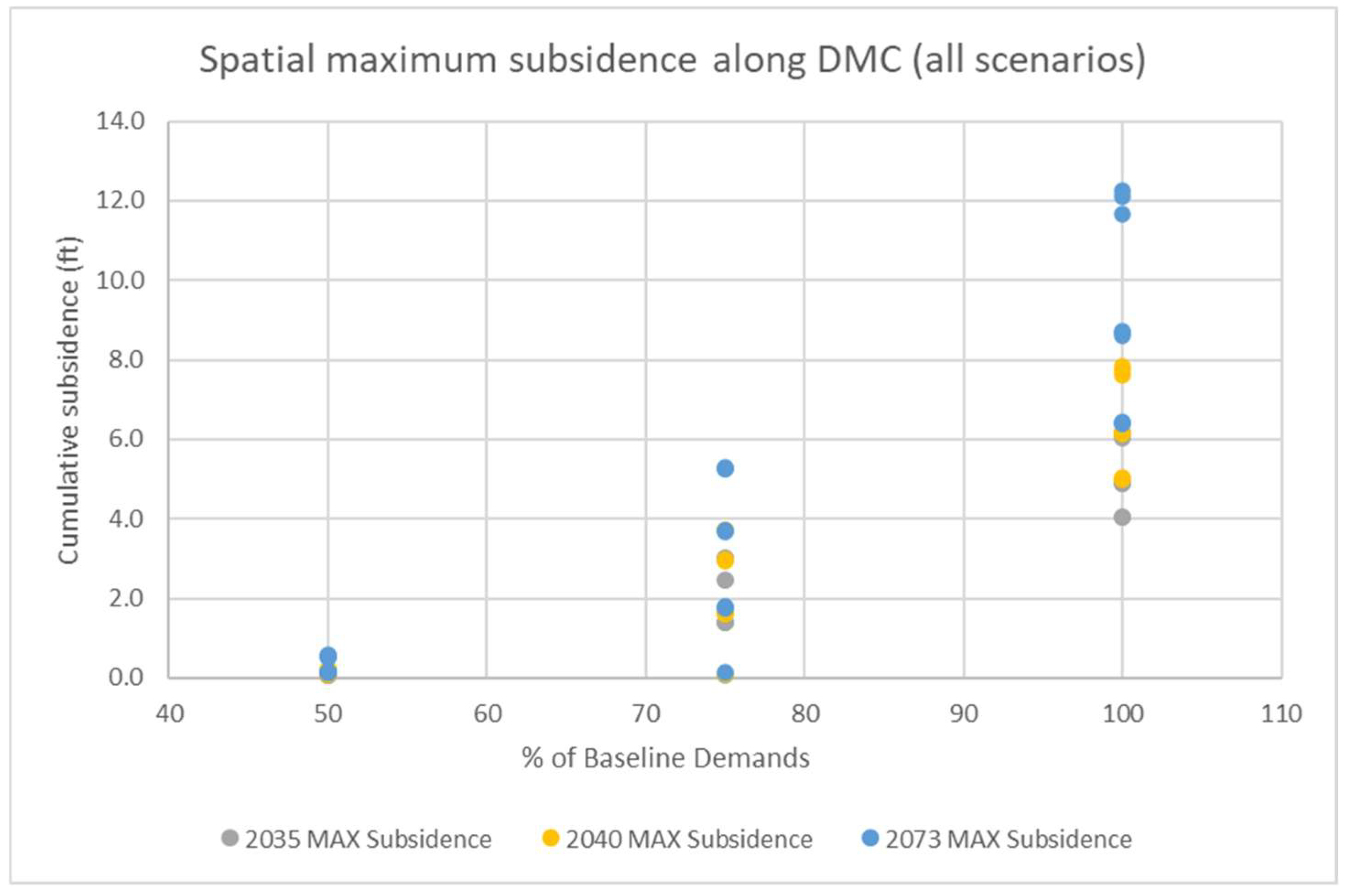
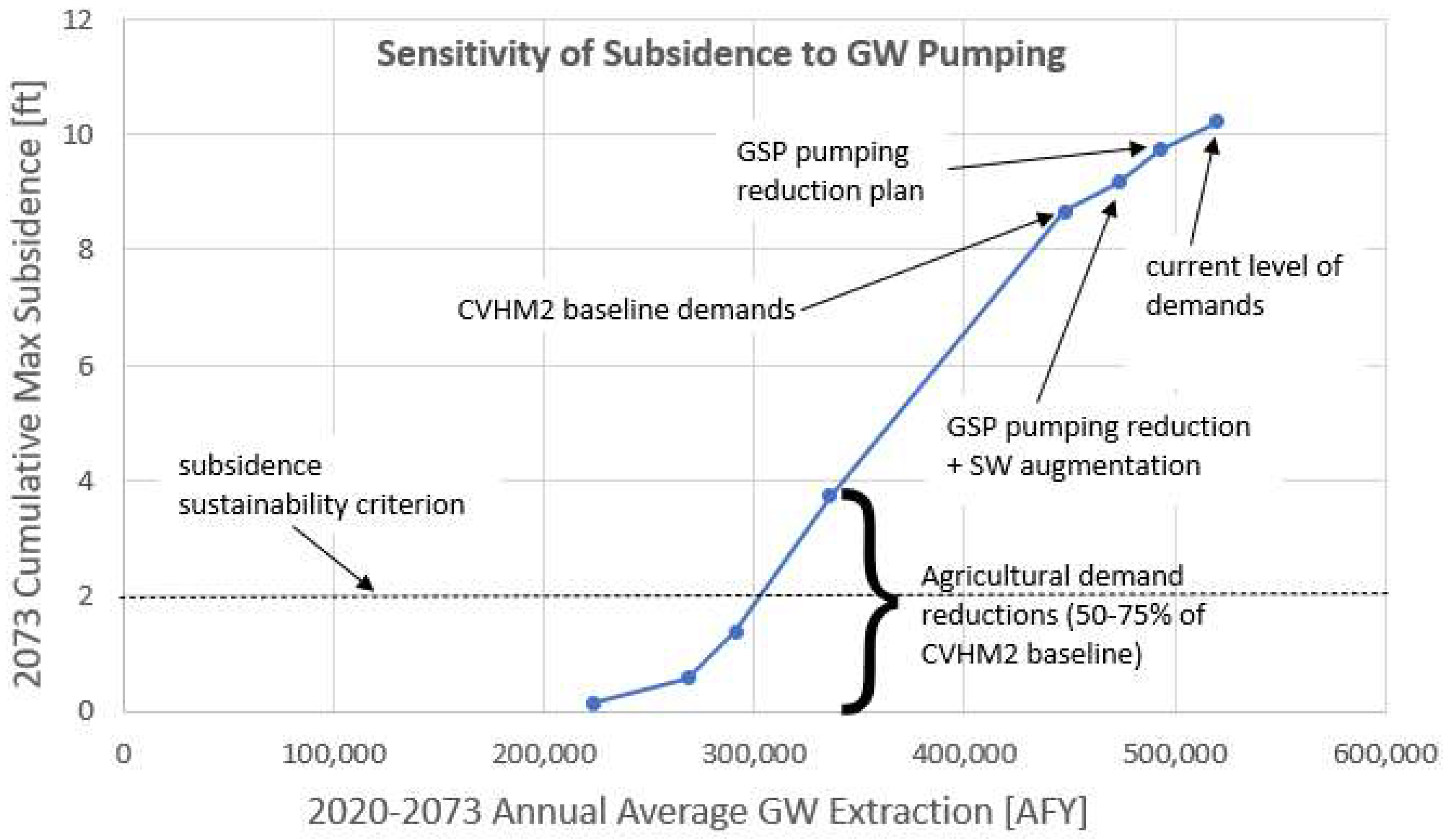

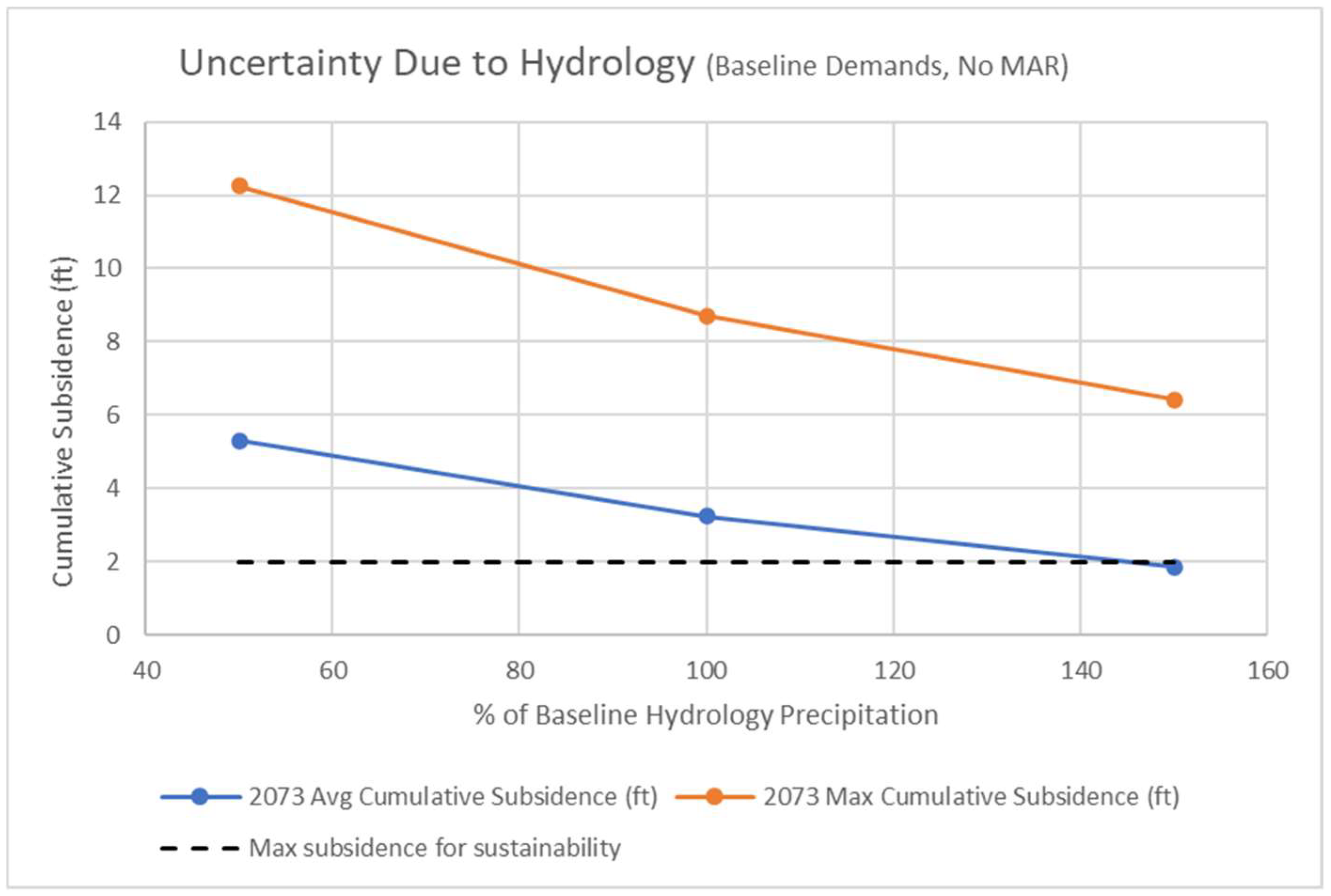
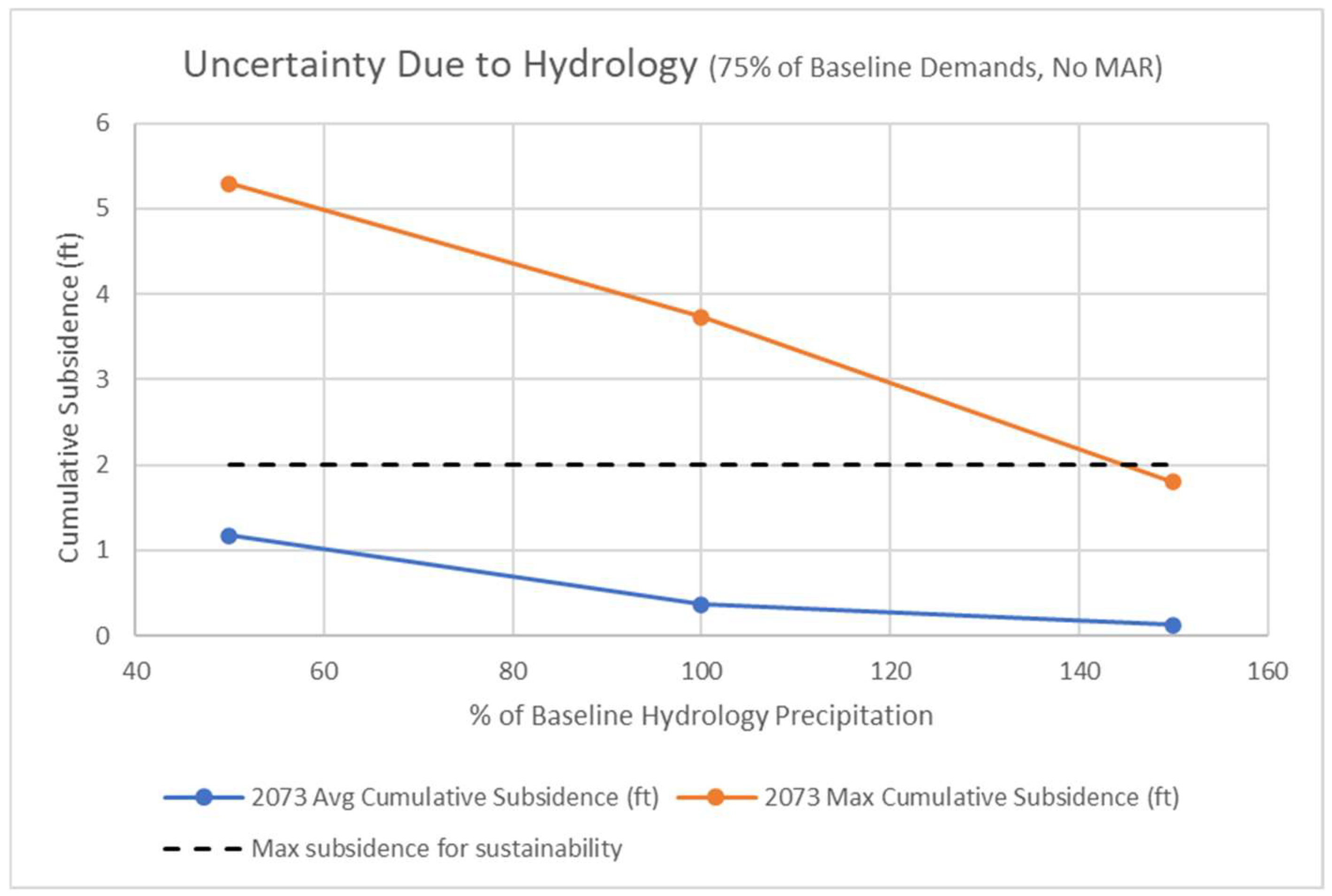

| Scenario # | Demands [m3/yr] | MAR [m3/yr] | Future Precipitation [% of Current] |
|---|---|---|---|
| 1 | 2.75 × 108 | 0 | 100 |
| 2 | 4.14 × 108 | 0 | 100 |
| 3 | 5.52 × 108 | 0 | 100 |
| 4 | 2.75 × 108 | 8.18 × 107 | 100 |
| 5 | 4.14 × 108 | 8.18 × 107 | 100 |
| 6 | 5.52 × 108 | 8.18 × 107 | 100 |
| 7 | 2.75 × 108 | 2.04 × 108 | 100 |
| 8 | 4.14 × 108 | 2.04 × 108 | 100 |
| 9 | 5.52 × 108 | 2.04 × 108 | 100 |
| 10 | 2.75 × 108 | 0 | 50 |
| 11 | 4.14 × 108 | 0 | 50 |
| 12 | 5.52 × 108 | 0 | 50 |
| 13 | 2.75 × 108 | 8.18 × 107 | 50 |
| 14 | 4.14 × 108 | 8.18 × 107 | 50 |
| 15 | 5.52 × 108 | 8.18 × 107 | 50 |
| 16 | 2.75 × 108 | 2.04 × 108 | 50 |
| 17 | 4.14 × 108 | 2.04 × 108 | 50 |
| 18 | 5.52 × 108 | 2.04 × 108 | 50 |
| 19 | 2.75 × 108 | 0 | 150 |
| 20 | 4.14 × 108 | 0 | 150 |
| 21 | 5.52 × 108 | 0 | 150 |
| 22 | 2.75 × 108 | 8.18 × 107 | 150 |
| 23 | 4.14 × 108 | 8.18 × 107 | 150 |
| 24 | 5.52 × 108 | 8.18 × 107 | 150 |
| 25 | 2.75 × 108 | 2.04 × 108 | 150 |
| 26 | 4.14 × 108 | 2.04 × 108 | 150 |
| 27 | 5.52 × 108 | 2.04 × 108 | 150 |
| Scenario # | 2020–2035 AVG Subsidence (ft) | 2020–2040 AVG Subsidence (ft) | 2020–2073 AVG Subsidence (ft) |
|---|---|---|---|
| 1 | 0.01 | 0.03 | 0.04 |
| 2 | 0.22 | 0.29 | 0.37 |
| 3 | 1.77 | 2.24 | 3.24 |
| 4 | 0.01 | 0.03 | 0.04 |
| 5 | 0.17 | 0.24 | 0.30 |
| 6 | 1.75 | 2.21 | 3.19 |
| 7 | 0.01 | 0.03 | 0.04 |
| 8 | 0.20 | 0.27 | 0.34 |
| 9 | 1.73 | 2.19 | 3.13 |
| 10 | 0.02 | 0.05 | .07 |
| 11 | 0.63 | 0.80 | 1.17 |
| 12 | 2.52 | 3.27 | 5.30 |
| 13 | 0.02 | 0.05 | 0.07 |
| 14 | 0.61 | 0.77 | 1.14 |
| 15 | 2.47 | 3.21 | 5.22 |
| 16 | 0.02 | 0.05 | 0.07 |
| 17 | 0.60 | 0.75 | 1.10 |
| 18 | 2.42 | 3.14 | 5.11 |
| 19 | 0.01 | 0.03 | 0.02 |
| 20 | 0.07 | 0.12 | 0.13 |
| 21 | 1.13 | 1.42 | 1.85 |
| 22 | 0.01 | 0.03 | 0.02 |
| 23 | 0.07 | 0.12 | 0.12 |
| 24 | 1.11 | 1.41 | 1.83 |
| 25 | 0.01 | 0.03 | 0.02 |
| 26 | 0.07 | 0.11 | 0.12 |
| 27 | 1.10 | 1.39 | 1.81 |
| Scenario # | 2020–2035 MAX Subsidence (ft) | 2020–2040 MAX Subsidence (ft) | 2020–2073 MAX Subsidence (ft) |
|---|---|---|---|
| 1 | 0.07 | 0.10 | 0.15 |
| 2 | 2.47 | 2.96 | 3.73 |
| 3 | 4.90 | 6.19 | 8.71 |
| 4 | 0.07 | 0.10 | 0.15 |
| 5 | 2.45 | 2.94 | 3.70 |
| 6 | 4.89 | 6.17 | 8.67 |
| 7 | 0.07 | 0.10 | 0.15 |
| 8 | 2.45 | 2.93 | 3.68 |
| 9 | 4.88 | 6.16 | 8.62 |
| 10 | 0.16 | 0.23 | 0.58 |
| 11 | 3.01 | 3.71 | 5.29 |
| 12 | 6.19 | 7.82 | 12.26 |
| 13 | 0.14 | 0.21 | 0.55 |
| 14 | 3.01 | 3.70 | 5.26 |
| 15 | 6.10 | 7.72 | 12.12 |
| 16 | 0.13 | 0.19 | 0.51 |
| 17 | 3.02 | 3.70 | 5.25 |
| 18 | 6.02 | 7.63 | 11.66 |
| 19 | 0.07 | 0.10 | 0.13 |
| 20 | 1.41 | 1.64 | 1.80 |
| 21 | 4.05 | 5.03 | 6.43 |
| 22 | 0.07 | 0.10 | 0.13 |
| 23 | 1.39 | 1.62 | 1.77 |
| 24 | 4.04 | 5.02 | 6.41 |
| 25 | 0.07 | 0.10 | 0.13 |
| 26 | 1.38 | 1.60 | 1.75 |
| 27 | 4.03 | 5.01 | 6.39 |
Disclaimer/Publisher’s Note: The statements, opinions and data contained in all publications are solely those of the individual author(s) and contributor(s) and not of MDPI and/or the editor(s). MDPI and/or the editor(s) disclaim responsibility for any injury to people or property resulting from any ideas, methods, instructions or products referred to in the content. |
© 2025 by the authors. Licensee MDPI, Basel, Switzerland. This article is an open access article distributed under the terms and conditions of the Creative Commons Attribution (CC BY) license (https://creativecommons.org/licenses/by/4.0/).
Share and Cite
Nelson, K.; Quinn, N.; Traum, J. Central Valley Hydrologic Model Version 2 (CVHM2): Decision Support Tool for Groundwater and Land Subsidence Management. Water 2025, 17, 1120. https://doi.org/10.3390/w17081120
Nelson K, Quinn N, Traum J. Central Valley Hydrologic Model Version 2 (CVHM2): Decision Support Tool for Groundwater and Land Subsidence Management. Water. 2025; 17(8):1120. https://doi.org/10.3390/w17081120
Chicago/Turabian StyleNelson, Kirk, Nigel Quinn, and Jonathan Traum. 2025. "Central Valley Hydrologic Model Version 2 (CVHM2): Decision Support Tool for Groundwater and Land Subsidence Management" Water 17, no. 8: 1120. https://doi.org/10.3390/w17081120
APA StyleNelson, K., Quinn, N., & Traum, J. (2025). Central Valley Hydrologic Model Version 2 (CVHM2): Decision Support Tool for Groundwater and Land Subsidence Management. Water, 17(8), 1120. https://doi.org/10.3390/w17081120








